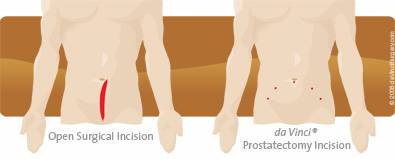da Vinci Expectations
Undergoing any sort of surgery can cause anxiety. Pursuing treatment with a surgical approach that is still new and unknown to many patients may further raise a number of questions. This section explains what happens before, during and after a robotic-assisted surgery using the da Vinci® Surgical System, and aims to dispel some of that anxiety by providing clear information on what you should expect from your procedure.
1. Initial Appointment
Many men simply go to a primary care physician for a routine check-up, only to get a call a few days later to report that something called an “elevated PSA” had shown up in their laboratory results and that further testing will need to be conducted by a urologist.
2. Laboratory Results
The exam likely consists of a standard digital rectal exam (DRE), in which the doctor manually palpates the prostate by way of the rectum. Even if the urologist detects nothing abnormal, he/she schedules a biopsy to be on the safe side. The biopsy is performed by inserting a tubular structure in the rectum, from which projectile needles collect 5-6 “cores” of tissue from each side of the prostate. Although many patients tolerate the biopsy without medication, the urologist may offer something to alleviate any discomfort and/or anxiety associated with the procedure.
3. Treatment Options
If the patient has an early diagnosis of prostate cancer, there is usually a range of treatment options. These may include conservative management, radiation therapy with external bream or brachytherapy, cryosurgery and prostatectomy – surgical removal of the prostate. The treatment options will depend on a number of factors, including the stage of the disease, the age and health or personal preference of the patient.
4. Pre-Operative
The patient will have a physical examination and discuss the various types of anesthesia with the anesthesiologist. This visit is arranged by the doctor and will likely occur the week before surgery. The evening before surgery the patient follows instructions for bowel preparation as provided by the doctor.
5. Day of Surgery
Shortly before the operation, anesthesia is administered and the patient goes to sleep for the duration of the operation, which typically lasts 2-4 hours. The procedure begins when the patient’s abdomen is inflated with carbon dioxide gas, creating an operating space for the surgeon. Next, six small incisions, 1/4 to 1/2 inch in length, are made in the patient’s abdomen and ports are inserted to keep the incisions open.
During the procedure, the surgeon uses the da Vinci System’s laparoscopic surgical instruments and video camera, via the temporary ports, to direct the dissection of the prostate gland and adjacent tissue. If deemed appropriate, the surgeon tries to preserve the nerves attached to the patient’s prostate gland. At the end of the surgery, the ports are removed from the patient’s abdomen and the remaining incisions are closed with sutures.
For detailed information about this procedure, please talk to a surgeon who performs da Vinci Prostatectomy.
6. Post-Operative
The patient wakes up very groggy and with a urinary catheter in place. He will likely spend one night in the hospital resting and recovering from the effects of the anesthesia. As the anesthesia wears off, there may be some discomfort, for which pain medication may be prescribed. During this time, the medical team gets the patient sitting, standing and eventually walking around, which is recommended throughout the recovery period. Because a catheter typically remains in place for approximately 7 days, the doctor will review guidelines for use that will ease discomfort and ensure proper function of the catheter during this time.
7. Recovery Period
The first week post-operatively will likely be spent resting; however, frequent walks are encouraged. Depending on the individual, regular activities may resume as soon as soon as a few days after surgery; straining and heavy lifting is discouraged for the first four weeks post-operatively. Approximately one week after surgery, a post-operative follow-up is scheduled, at which time bladder function may be assessed. This is done by filling the bladder with saline via the catheter, removing the catheter and then allowing the patient to void naturally. Some incontinence after surgery is normal and is typically managed with medication until bladder control resumes. Erectile dysfunction may also be a side effect of surgery. Like incontinence, this side effect may be discussed with the doctor and managed with medication until it lessens or completely resolves over time.
8. Follow-Up Care
After treatment for prostate cancer, the doctor will want to watch the patient carefully, checking to see if his cancer recurs or spreads further. The doctor should also outline a follow-up plan. This plan usually includes regular doctor visits, PSA blood tests and digital rectal exams, which will likely begin within a few months of finishing treatment. Most doctors recommend PSA tests about every 6 months for the first 5 years after treatment, and at least yearly after that.